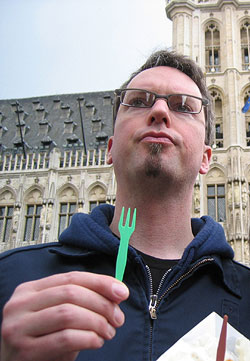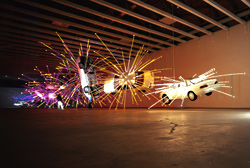The title of Chris Crites’ current exhibit at Joe Bar on Capitol Hill echoes Martin Luther King Jr.: “I Was Proud of My Crime.” The show consists of portraits of civil rights activists arrested during the 1956 Montgomery bus boycott, deftly painted in vivid acrylic on simple, unfolded brown paper bags.
Seattle Weekly: I’m sure you’ve been asked this many times over, but how did you happen upon brown paper bags as your canvas of choice? Was it a question of economics or aesthetics? Or both? Or do you feel that the simple, low-budget material suits your subject matter?
Crites: It was actually 10 years ago I began using charcoal and white conté crayon on paper bag. The way the wrinkles, folds, and texture added to a piece really appealed to me. In 1999, I painted my first four mug shots in acrylic on paper bag with a limited palette of five colors each. Paper bag has been my main substrate ever since. Brightly colored acrylics have a different effect for me on the brown bag than on a typical white backing. Criminal mug shot photos have always interested me due to the stories they hide. I can look at an old black-and-white mug shot, sometimes knowing the charge, sometimes not, and really wonder what had happened, who these people were and what drove them to do whatever it was that they did. I try to bring new life to these practically discarded portraits of criminal history. Using an everyday, discardable item as the surface gives new life to the bag as well. It may sound cliché, but the combination of the mug shot, the limited, bright palette and the brown bag really worked for me, so I have stuck with it.
Do you feel any kinship with (or inspiration from) local longtime artist James Martin, who also likes to paint on brown paper?
Embarrassingly enough, I am not familiar with James Martin. People have asked me that before and someone described his work to me. I believe there may have been another artist or more from the area that worked on brown paper and cardboard in the 1970s? I really need to do my homework there.
Can you give me an overview of your past brown bag series? Did they start with paintings of old photos of 19th-century bandits? Were they notorious figures (mobsters and outlaws and such)—or just anonymous characters?
The main focus of my work has been anonymous mug shots from the 1890s to 1950s. A lot of them are petty criminals, small things like stealing a coat, or a bike, or $5 from someone. I am fascinated by history, and the clothing, the expressions these people wear really appeal to me. There is so much of a story behind each one, and we may never know what it really is. Once in a while, I do more well-known characters and portraits as well. My last series in February was people from the 1980s, which was a huge departure for me, but it was fun and fit the venue in Ballard which sells ’80s clothing and accessories.
Your current exhibit of “mug shots” is a little different from past series of this title in that the “criminals” are in fact activist heroes, right? Or have you used “mug shots” as an ironic title in the past as well? What made you decide to do portraits of the Montgomery bus boycott protesters?
This current series is somewhat different than my previous work. I mainly stay with criminal mug shots from the 1890s to 1950s. Generally they are all anonymous. After Rosa Parks’ death, a Montgomery, Ala., deputy apparently “found” all of the boycott arrest booking photos in storage. There had been 156 arrests. Once I saw these photos, I really wanted to do this series. The fact that these men and women were arrested and booked for standing up for their civil rights only 50 years ago got me thinking about where our rights, or especially those of foreigners in our country, stand today. My father was active in the civil rights movement in Missouri in the 1950s and 1960s, and I did not know a great deal about much that happened. I wanted to do a series that would hopefully get people to think about our country’s racist history and think about how much we all stand to lose. As for the other people in this new series, unfortunately I do not have their names, only the numbers they were photographed with. Obviously Martin Luther King Jr. and Rosa Parks became so well known that they are easily recognizable.
What effect are you hoping to have by depicting people like MLK Jr. and Rosa Parks this way?
Again, the effect I hope to get from painting these images in this way is to get people to think. To think about what some people think of as rights, and others in power think of as crimes. Protesting injustice, or protesting a war . . . doesn’t necessarily make one a criminal.
What’s your artistic training and background?
Originally I went to school for graphic design and illustration. I have an associate’s degree and a bachelor’s degree in arts. Illustration did not work out for me, as I did not like finishing a piece only to have someone else tell me it was wrong and to do it over and over again. I wanted to do what I wanted, so I decided to paint whatever I wanted.








